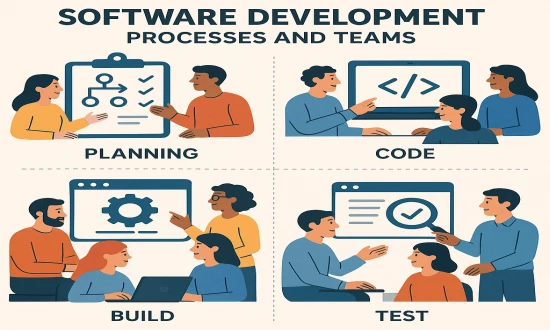1. Software Development Processes
Software development processes define how software is planned, built, tested, and delivered. The choice of process influences the timeline, flexibility, and overall success of a project. Below are the most commonly used models.
1.1 Waterfall Model
A traditional, linear, and sequential approach.
Each phase must be completed before the next begins:
- Requirements
- Design
- Development
- Testing
- Deployment
- Maintenance
Best for: Projects with fixed requirements, limited changes, and strict documentation needs.
1.2 Agile Development
An iterative and flexible approach focusing on collaboration, adaptability, and continuous delivery.
Key principles include:
- Short development cycles (sprints)
- Frequent feedback from stakeholders
- Continuous improvement
- Minimal documentation but high communication
Best for: Projects with evolving requirements and dynamic environments.
1.3 Scrum Framework
A popular Agile method that divides work into 1–4 week sprints.
Roles include:
- Product Owner: Defines requirements and priorities
- Scrum Master: Facilitates the process and removes obstacles
- Development Team: Builds and delivers product increments
Events: Daily standups, sprint planning, sprint review, retrospectives.
1.4 Kanban Method
A visual, flow-based approach focused on managing ongoing work.
- Uses a Kanban board (To Do, In Progress, Done)
- Emphasizes work-in-progress (WIP) limits
- Continuous delivery rather than time-boxed sprints
Best for: Support teams and continuous workflow environments.
1.5 DevOps
A combination of development and operations aimed at automating and accelerating delivery.
Core practices:
- Continuous Integration (CI)
- Continuous Deployment (CD)
- Infrastructure as Code (IaC)
- Automated testing and monitoring
Best for: Large-scale systems, cloud-based products, and fast releases.
2. Software Development Teams
A software development team is a group of professionals with diverse expertise who collaborate to build software. Team structure varies by methodology and project complexity.
2.1 Key Roles in a Software Development Team
1. Product Owner / Project Manager
- Defines the product vision
- Manages requirements, timelines, and priorities
- Communicates with stakeholders
2. Software Developers / Engineers
- Write clean, efficient, and scalable code
- Implement features and fix issues
- Participate in code reviews
3. QA/QC Testers
- Ensure the software works correctly
- Design and execute test cases
- Report and track bugs
- Perform manual and automated testing
4. UI/UX Designers
- Create intuitive user experiences
- Design user interfaces, layouts, and interactions
5. DevOps Engineers
- Manage CI/CD pipelines
- Handle deployment automation
- Monitor software performance in production
6. Business Analysts
- Translate business needs into technical requirements
- Bridge communication between business and technical teams
7. System Architects
- Design system structure
- Select technology stack and define architecture patterns
8. Support & Maintenance Team
- Monitor performance
- Fix issues after deployment
- Provide customer support
3. Team Structures
3.1 Cross-Functional Teams
Teams include members from different disciplines (developers, QA, design, DevOps).
Best for Agile and Scrum.
3.2 Specialized Teams
Each team focuses on a specific area (QA team, mobile team, backend team).
Best for large organizations.
3.3 Feature Teams
Each team owns a particular product feature from design to release.
Useful for modular applications.
3.4 Component Teams
Teams focus on separate technical components (database, API, UI).
Best for complex software systems.
4. Why Processes and Teams Matter
- Ensures high product quality
- Reduces development risks
- Improves communication
- Increases delivery speed
- Helps manage changes efficiently
- Aligns technical and business goals
An organized development process combined with the right team structure is essential for creating reliable, scalable, and user-centered software.



